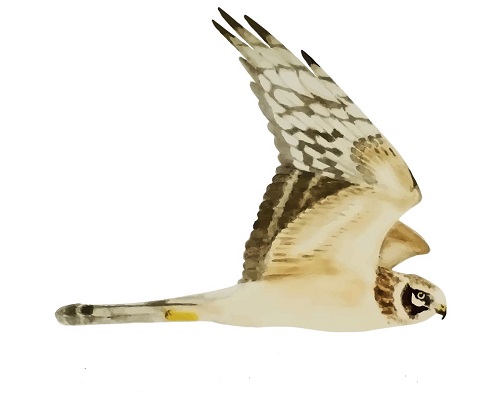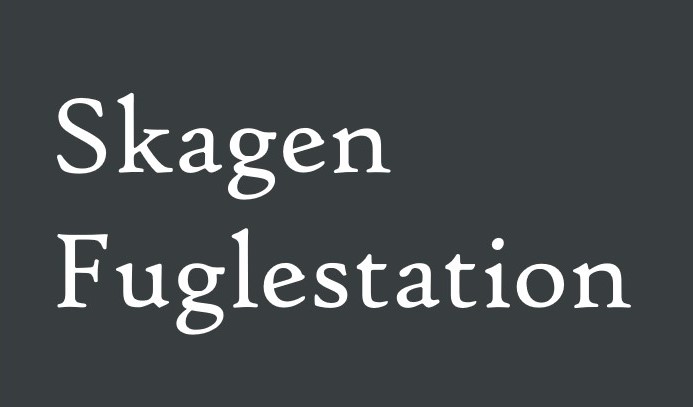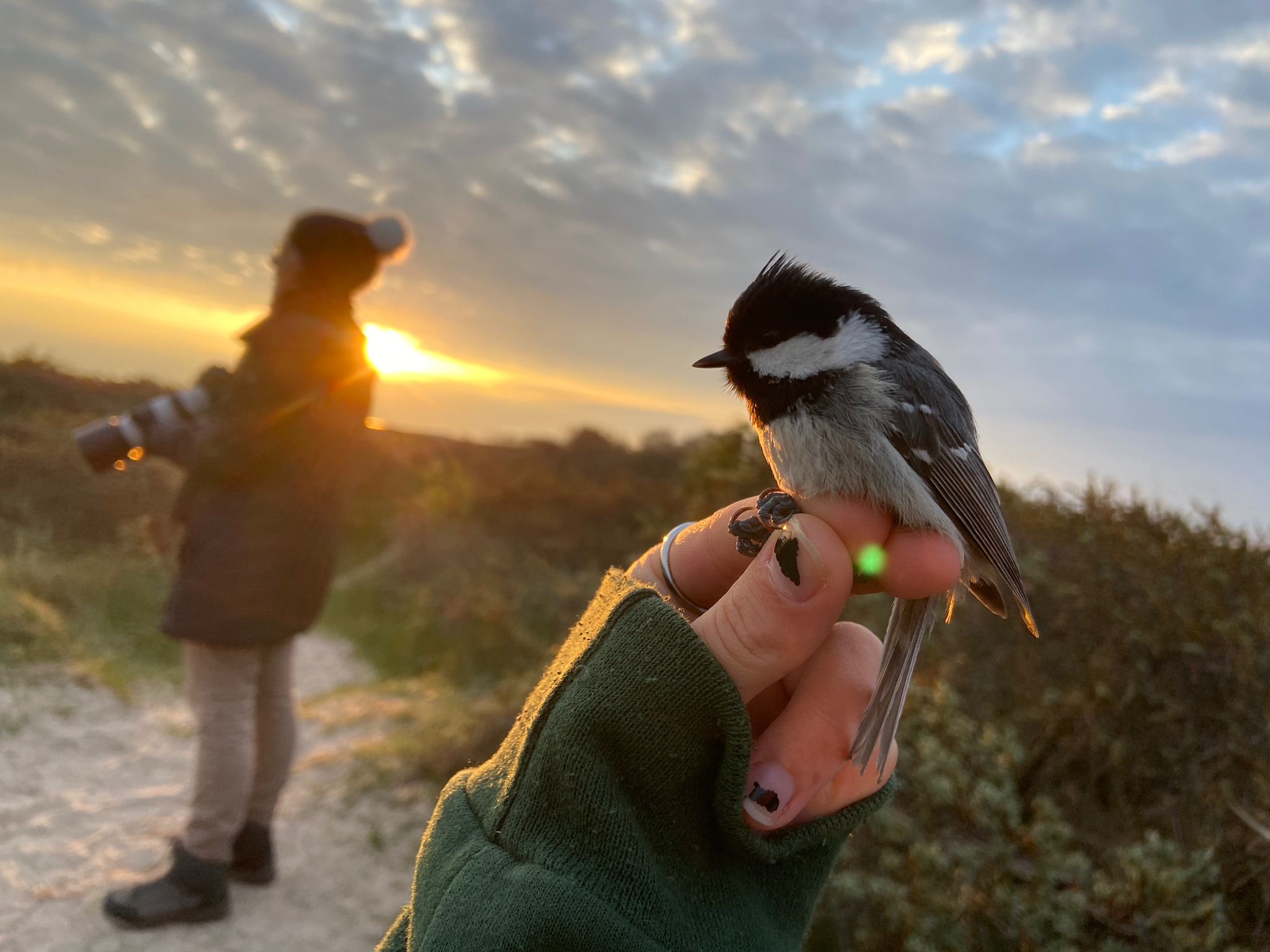Her på Skagen Fuglestations blog bringes korte nyheder i dagbogsformat om hændelser på fuglestationen.
Red-throated or Red-footed?
Many birds have red in their plumage. Some of them on their head, some on their wings. Other ones have a red body and even other birds have a red tail. For some of those birds the red body part is used to give it a simple and hopefully never misleading name. Two of those lucky birds made our day today.
It was a sunny morning buøgt the increasing southeasterly wind (which was very welcomed by us bird lovers) made it feel comfortable today. It took some time until the air heated up and gave us the feeling of summer again. Even if there was more migration than the last days, it was still slow. Luckily, there was a nice variety of species. Two Great Nothern Divers (Islom) flew over and a young Pallid Harrier (Steppehøg).
Then I heard some familiar calls and directly shouted "Red-thorated Pipit" (Rødstrubet Piber)!! It called a few more times and Magnus seemed to be alredy really happy, since it was a new species for him. Finally, we found the flying bird in the air and saw it landing behind some grass. Afterwards it was foraging with Yellow Wagtails (Gul Vipstjert). What a nice bird, the first one I could take pictures of:

In the meanwhile, ringing was better than the previous days but the highlights were missing. Finally, the ringers got reawarded with a nice Wood Warbler (Skovsanger). This yellow bird really contrasted to the less yellow Willow Warblers - especially to one completely grey one - probably ssp. acredula.
Simon Sr. had a tour for a school class, so we set up a new net to catch more birds in the old lighthouse garden. Unfortunately, there were no birds to ring in the bright sunshine. Thanks to Simon Srs engagement, this kids still had fun.

In the afternoon, Mira and I went to the Black Summerhouse to look for raptors. It was really fun and we had the second bird, which is named after its red on its body. Red-footed Falcon (Aftenfalk)! Three different birds (M ad, M 2k, F 2k) came by super close and gave us nice views.
The wind brought good birds to Skagen and we look back on good birds we have seen. Unfortunately, there is no way to see all the nice birds, since you can not be everywhere at the same time. But that's okay. Sometimes it is hard to accept, that there were good birds, you could not see. That's part of the game. Luckily, there are still enough nice birds for everyone of us and many more to come. Fingers crossed that the next days continue like this!
Today’s observations in Dofbasen from observers in the area.
Sum of the raptors in the area based on observations typed into Dofbasen the same day.
People: Séan Walsh, Hayley Land, Isis Khalil, Magnus Houen Lauritsen, Simon Kiesé, Simon S. Christiansen, Mira Kieckbusch, Karen Marie Holk
Weevil Kingdom
Hello everyone, I hope you all enjoyed the 2024 Skagen Fuglefestival (Bird Festival)! Maybe you were one of the lucky hundred who came to see the Eurasian Wryneck (Vendehals) getting ringed yesterday, that was super exciting!
Last night we made an attempt to see the Northern Lights again, since they were supposed to be as vibrant as the day before. However, when our 12:30 alarm went off, we were very disappointed to see dark skies and no lights. So we crawled back in bed for the last couple hours of sleep we could get before preparing for the day…
Today started out much like yesterday, but with even less birds in the nets. And unfortunately, the slow trend stayed throughout the day without any exciting surprises during our closing round (we closed early since we had several rounds in a row with 0 birds).
The pace of ringing did not take away from our fun, however, since on slow days like today we get to really admire all the little details of the environment we spend all our mornings in. For one, the dew on the webs in the reeds looked particularly stunning in the sunrise today, we were very cautious not to leave any of the spiders homeless (they work hard catching and eating all the pesky mosquitoes!).
Spiderwebs in the soft sunrise reeds.
Charlotte’s Web.
Aside from appreciating the intricate designs of the spiderwebs, we also befriended some sweet little weevils.
Weevil.
And did a little ringing as well…
Dunnock (Jernspurv).
Near the late morning, we started having several rounds with no birds at all. Instead, we kept busy chatting with the local birders and building sand castles:
Hayley creating a Weevil Kingdom.
Mayday! The weevils are being attacked by an evil tapeworm! But fret not, an unknown force (Séan) has turned the evil tapeworm into a flag that now waves as a warning to all offenders.
In hindsight, maybe the long days and short nights are starting to play tricks on our minds…
The count, which Mira and Simon (Jr) took care of, was as slow as ringing, but I’m sure they, too, managed to find fun things to do to pass the time. Simon (Jr) got a lovely picture of a Common Cuckoo (Gøg), it is so nice to hear their song around the dunes these days!
Common Cuckoo (Gøg). Picture by: Simon Kiesé.
Magnus and Johanna were MIA for most of the day, but they somehow saw all the rare birds around Skagen! This includes the Lesser Spotted Eagle (Lille Skrigeørn), the odd Wagtail (Vipstjert) –whose identification remains up for discussion, and the Black Stork (Sort Stork). Talk about lucky, Magnus did not even have his Zello on! These birds are a pretty good summary of today’s arrivals in Skagen, although the Lesser Spotted Eagle (Lille Skrigeørn) and the Black Stork (Sort Stork) turned around fairly early (by Flagbakken). Hopefully they will still turn up at the tip within the next few days.
In the afternoon, we got to work entering data and checking sheets with Simon (Sr). Then we welcomed our new guest and invited her to come see our fieldwork tomorrow, she had come to see the Eurasian Wryneck (Vendehals) yesterday, so she has had a little exposure to the work we do.
We also got some much-needed rest, then ate leftovers from when Søren cooked for us, very delicious.
See you out in the field!
Skifte.
Ringing (Kabeltromlekrattet)
Dunnock (Jernspurv) 2
Song Thrush (Sangdrossel) 1
Eurasian Blackcap (Munk) 1
Lesser Whitethroat (Gærdesanger) 1
Willow Warbler (Løvsanger) 4
Common Chiffchaff (Gransanger) 1
Total: 10
Today’s observations in Dofbasen from observers in the area.
Sum of the raptors in the area based on observations typed into Dofbasen the same day.
People: Séan Walsh, Hayley Land, Isis Khalil, Magnus Houen Lauritsen, Simon Kiesé, Simon S. Christiansen, Jørgen Hulbæk, Knud Pedersen, Johanna Veentjer, Mira Kieckbusch, our new guest Karen Marie Holk
Not the quiet day we expected
Simon and Magnus' adventure had them returning to the station at around 1 o'clock in the morning, at which point it was prime time to see the aurora borealis. The skies thankfully kept clear for them to view it. Unfortunately, the rest of us had apparently decided sleeping was more important and groggily got out of bed for our daily ringing and observation routines.
Whilst Johanna, Mira and I went to Sandstormsvinget to count migrating birds. We were not expecting an amazing day for migration with the wind, but after the first hour passed, it was clear that almost no migration would occur today. The first hour after sunrise seemed to be the only time at which any proper migration occured. Even as the morning warmed up, there were no raptors to be seen in the sky until our counting period was finished.
There were some small highlights in our counts though; we did see one Dværgryle (Little Stint) flying above the beach.
After three hours of counting, I went to Kabeltromlen to check up on the ringing because nothing was happening at sea. To my surprise, nothing was happening at the ringing site either, though it was better than yesterday. Hayley and Isis decided to close the nets a little after 10 o'clock after what seemed to be a boring day. They were greeted rather rudely by a screeching Vendehals (Eurasian Wryneck) in the top shelf of one of our nets. Generally, only one of these birds is caught in Skagen Fuglestation's nets each year, so this was quite the bird to finish off our ringing session on the last day of the bird festival. It drew quite a crows after Simon announced it on Zello; with about 80-100 people coming to see us ring the bird!
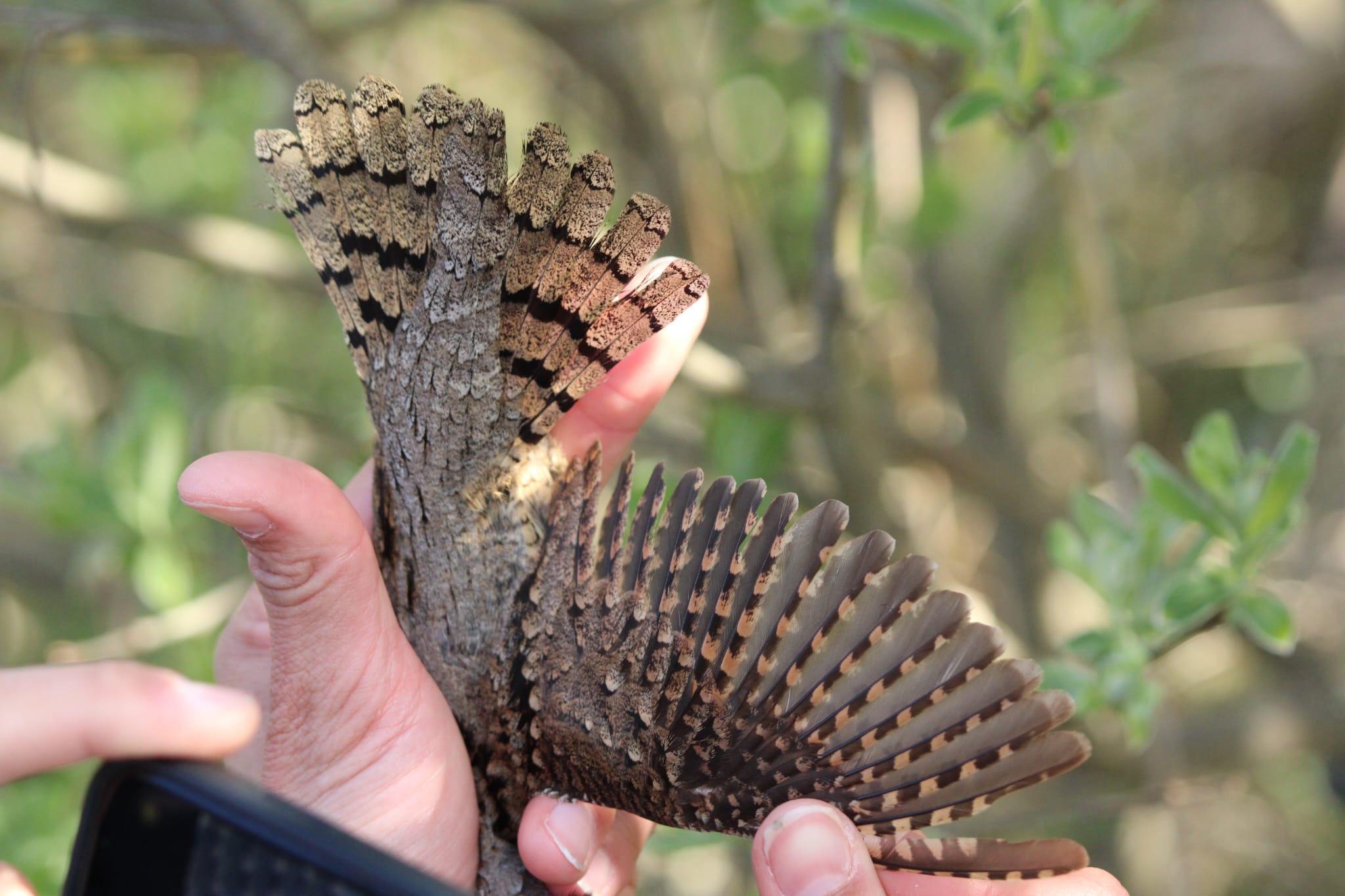
Lisa Vergin posing the bird for our picture archive.
Us volunteers returned to the station feeling good about today. We got some grunt work done around the station, when it was announced over Zello that an Alpe-jernspruv (Alpine Accentor) was found at Pælebakke Klit. It was a new species for many of the volunteers, and also a first for Lisa, so it was amazing to see. We joined around 200 other birders in the area for the birding festival to try to see the bird. We were treated to amazingly close views of <10m.

Among the birds in that locality was the local Steppeørn (Steppe Eagle) and Steppehøg (Pallid Harrier) which made for a very fine twitch.
We topped the day, and the birding festival off with an open grill for all of the birders to blow off a little steam and enjoy each others company.
Ringing (Kabeltromlekrattet):
| Wren | Gærdesmutte | 3 |
| Lesser Whitethroat | Gærdesanger | 2 |
| Willow Warbler | Løvsanger | 11 |
| Blackcap | Munk | 1 |
| Chiffchaff | Gransanger | 1 |
| Rødhals | Robin |
1 |
| Broget Fluesnapper | Pied Flycatcher | 1 |
| Rørspurv | Reed Bunting | 1 |
| Havesanger | Garden Warbler | 1 |
| Bogfinke | Common Chaffinch | 1 |
| Musvit | Great Tit | 1 |
| Munk | Blackcap | 3 |
| Vendehals | Wryneck | 1 |
Todays observations in DOFbasen from observers in the area
Sum of observations of raptors on DOFbasen from today
People: Séan Walsh, Hayley Land, Isis Khalil, Magnus Houen Lauritsen, Simon Kiesé, Johanna Veentjer, Simon S. Christiansen, Lisa Vergin, Søren, Jørgen Hulbæk, Knud Pedersen, and Oluf Lou.
Day Two of the Fuglefestival
After a very windy start to the Fuglefestival yesterday, Isis, Séan and I were hopeful for a good day at the ringing today. The weather was a lot calmer with hardly any wind at all. So lots of birds we thought!
Unfortunately, it turned out to be very very quiet with birds! But luckily there was no time to get bored as it was also very very busy with people. We have never seen so many bikes at our ‘parking spot’!
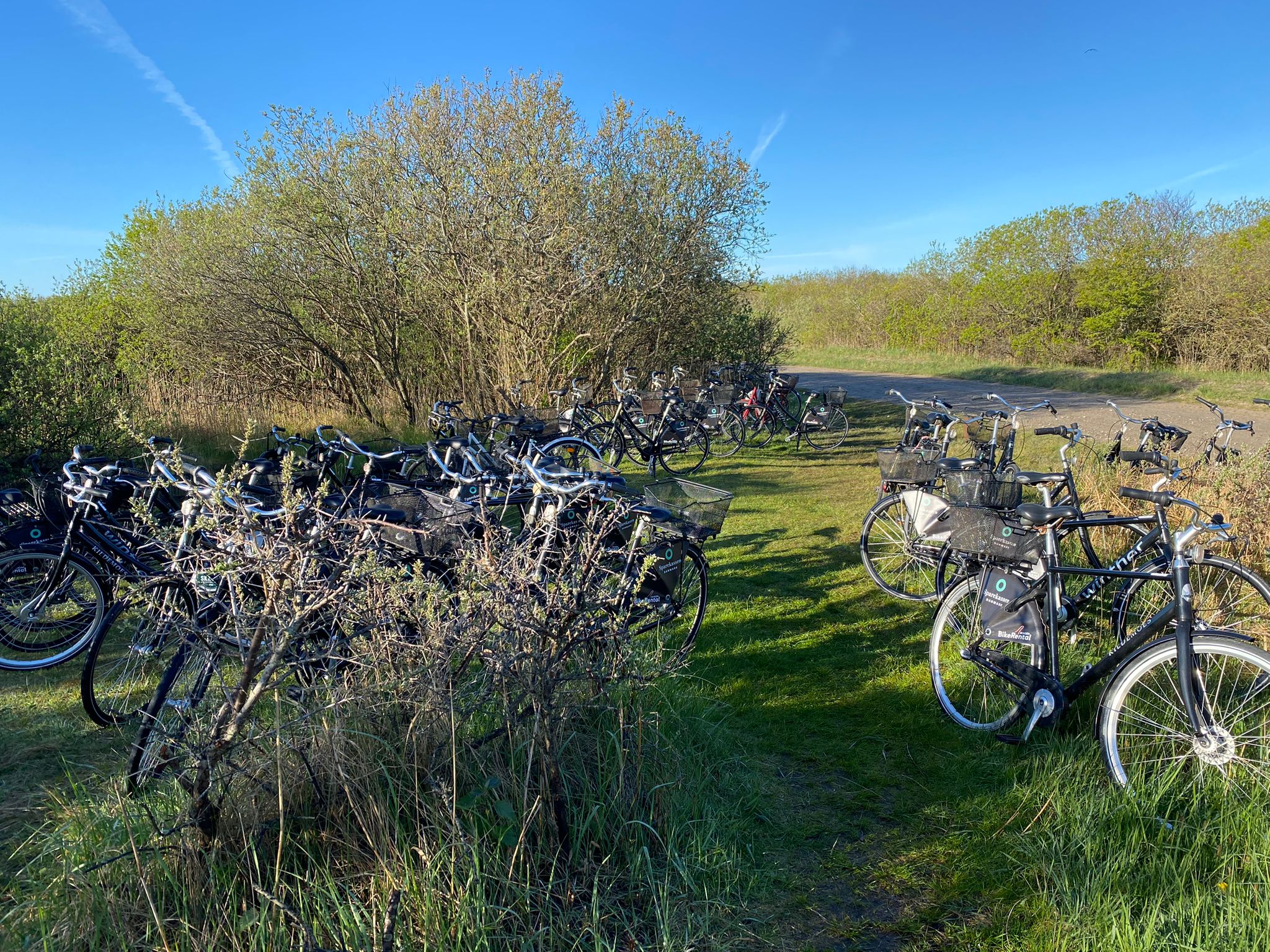
There was plenty of time to chat with all the different visitors, look for birds and eat cake (Tak Jørgen!). We also heard the Thrush Nightingale (Nattegal) again as we opened the nets. What a beautiful song. One of the other highlights was this lovely Garden Warbler (Havesanger), one of two we caught this morning.
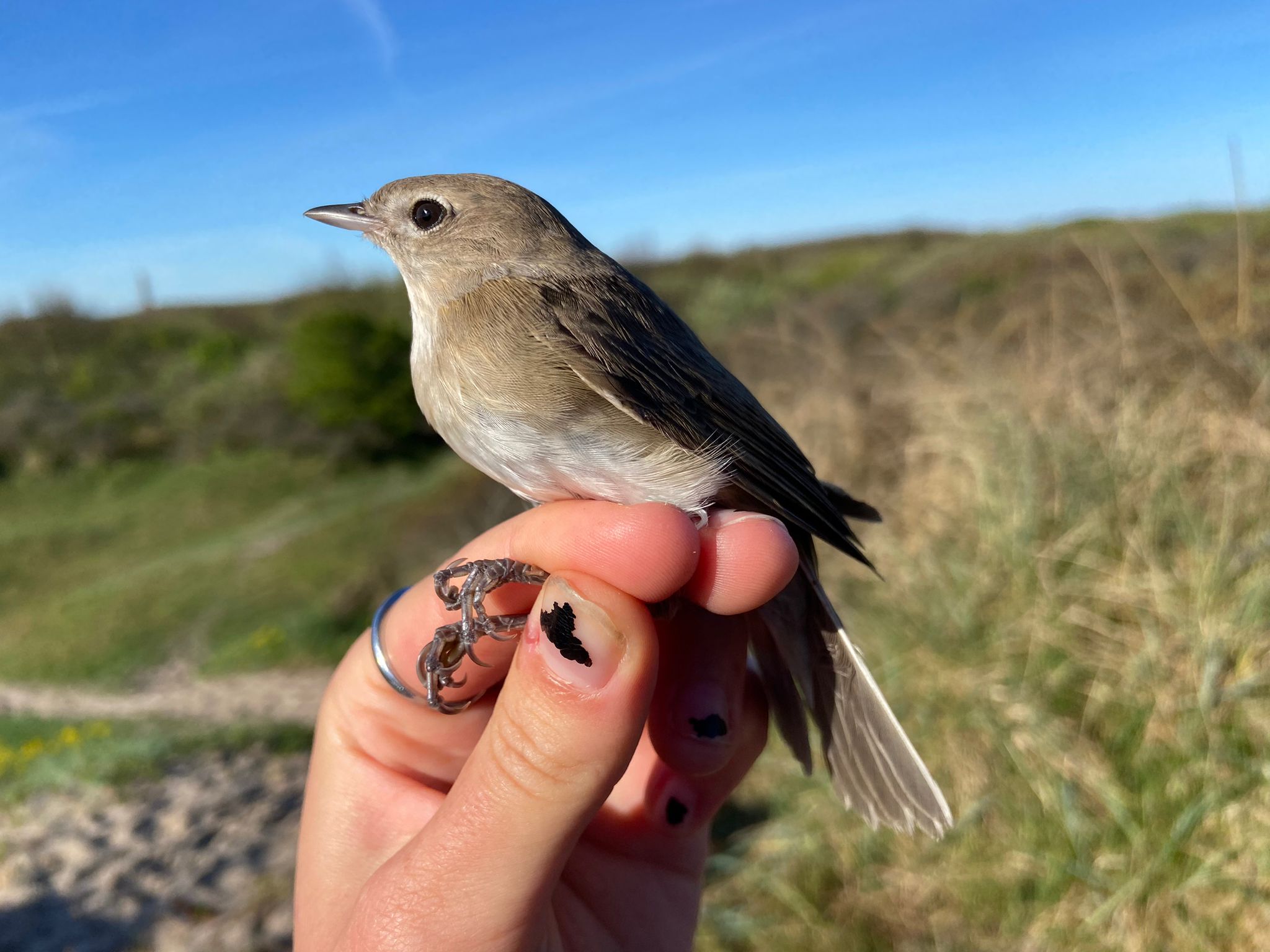
Garden Warbler - Havesanger
We were also very happy when we caught a Willow Warbler (Løvsanger) for Oluf Lou to ring. We have nicknamed this species Oluf Løvsanger after him. We think he was quite pleased about this!
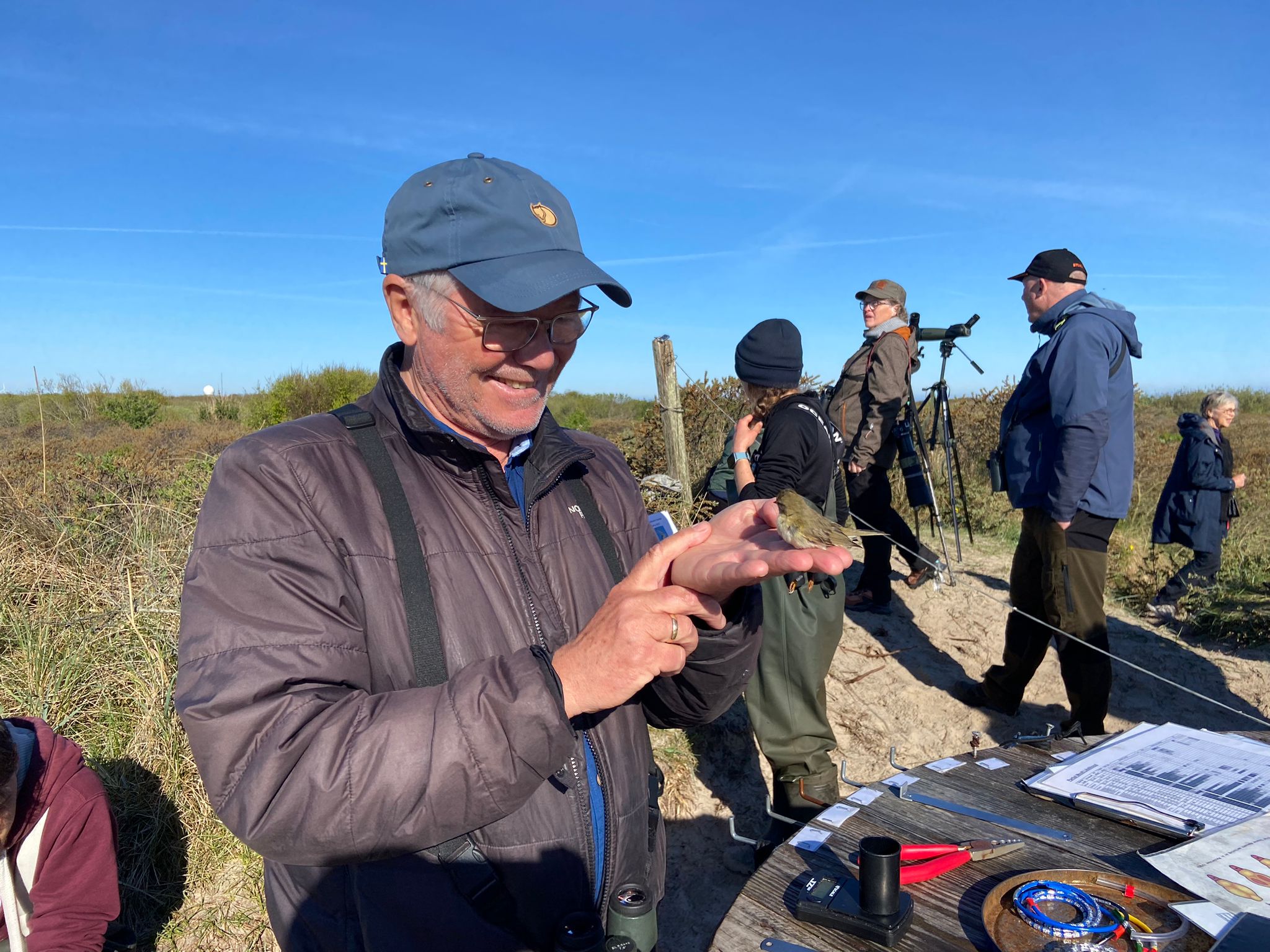
Oluf and an Oluf Løvsanger
Knud was out leading a tour this morning from Nordstrand as part of the Fuglesfestival and visited us at the ringing as did the Eagle Club. Luckily, we managed to catch one bird whilst they were all with us so we had something to show. Simon Sr explained the ringing process and then demonstrated how the birds are caught using one of the nets.
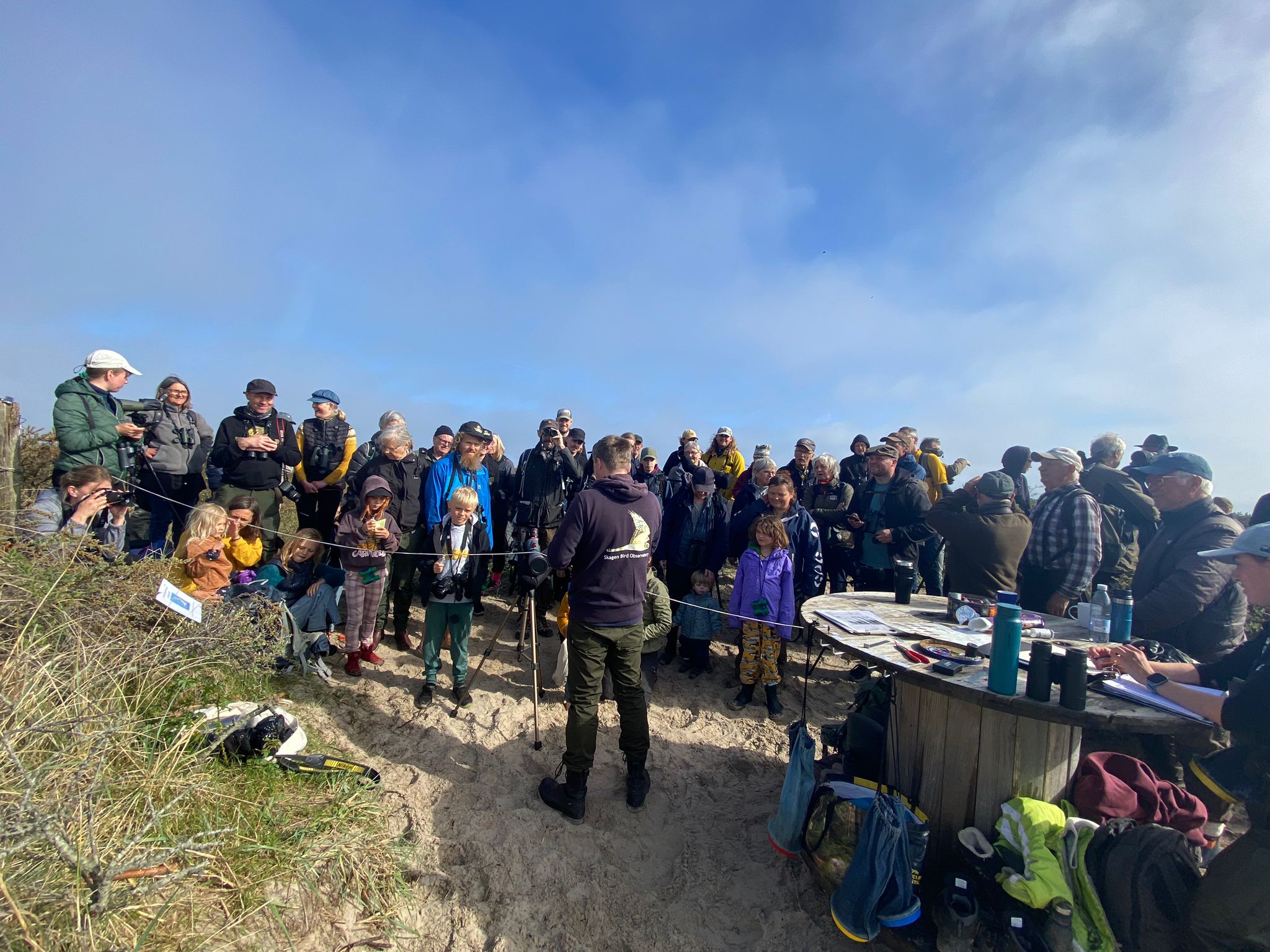
Simon Jr, Magnus and Johanna had a change of scenery this morning as they went to Sandormsvinget for the morning’s observations. One of the highlights was a female Citrine Wagtail (Citronvipstjært) which was originally roosting, then attempted to migrate. They also counted an impressive ten Fulmars (Mallemuk) and a Great Northern Diver (Islom). An adult female Montagu’s Harrier (Hedehøg) and the Steppe Eagle (Steppeørn) were the raptor highlights. They also saw a Golden Oriole (Pirol) which we also managed to spot from Kabeltromlen although it was very high and far away.
Simon and Magnus then set off on an epic adventure to Zealand to try and see the Rufous-chested Swallow (Rødbrystet Svale) which was first reported yesterday. If accepted this will be the first record of the species in the whole of the Western Palearctic. We really hope they find it!
Meanwhile, Séan, Isis and I went to watch Lisa’s presentation on her PhD work on Taiga Bean Geese (Sædgås). Even though we couldn’t understand much, as none of us speak Danish, it was interesting to look at the graphs and we enjoyed seeing the photos too.

We also managed to hear (but sadly not see!) a Bee-eater (Biæder) fly over the lighthouse. Now we are finishing our day by entering data and looking forward to our dinner which Søren has very kindly offered to cook for us.
Ringing (Kabeltromlekrattet):
| Wren | Gærdesmutte | 2 |
| Lesser Whitethroat | Gærdesanger | 1 |
| Garden Warbler | Havesanger | 2 |
| Blackcap | Munk | 1 |
| Chiffchaff | Gransanger | 1 |
| Willow Warbler | Løvsanger | 9 |
Total: 16
Today’s observations in Dofbasen from observers in the area.
Sum of the raptors in the area based on observations typed into Dofbasen the same day.
People: Séan Walsh, Hayley Land, Isis Khalil, Magnus Houen Lauritsen, Simon Kiesé, Johanna Veentjer, Simon S. Christiansen, Lisa Vergin, Søren, Jørgen Hulbæk, Knud Pedersen, Oluf Lou, and our guests Marianne and Kurt.
Skagen Fuglefestival and possible Indigo Bunting!
Endelig kom dagen, hvor Skagen Fuglefestival blev skudt i gang. Åbningstalen blev afholdt af DOF’s formand, Egon Østergaard, der med rette havde set frem til netop denne dag. Men inden vi når så langt, havde Skagen Fuglestation som sædvanligvis været i felten. Og det gik ikke stille for sig!
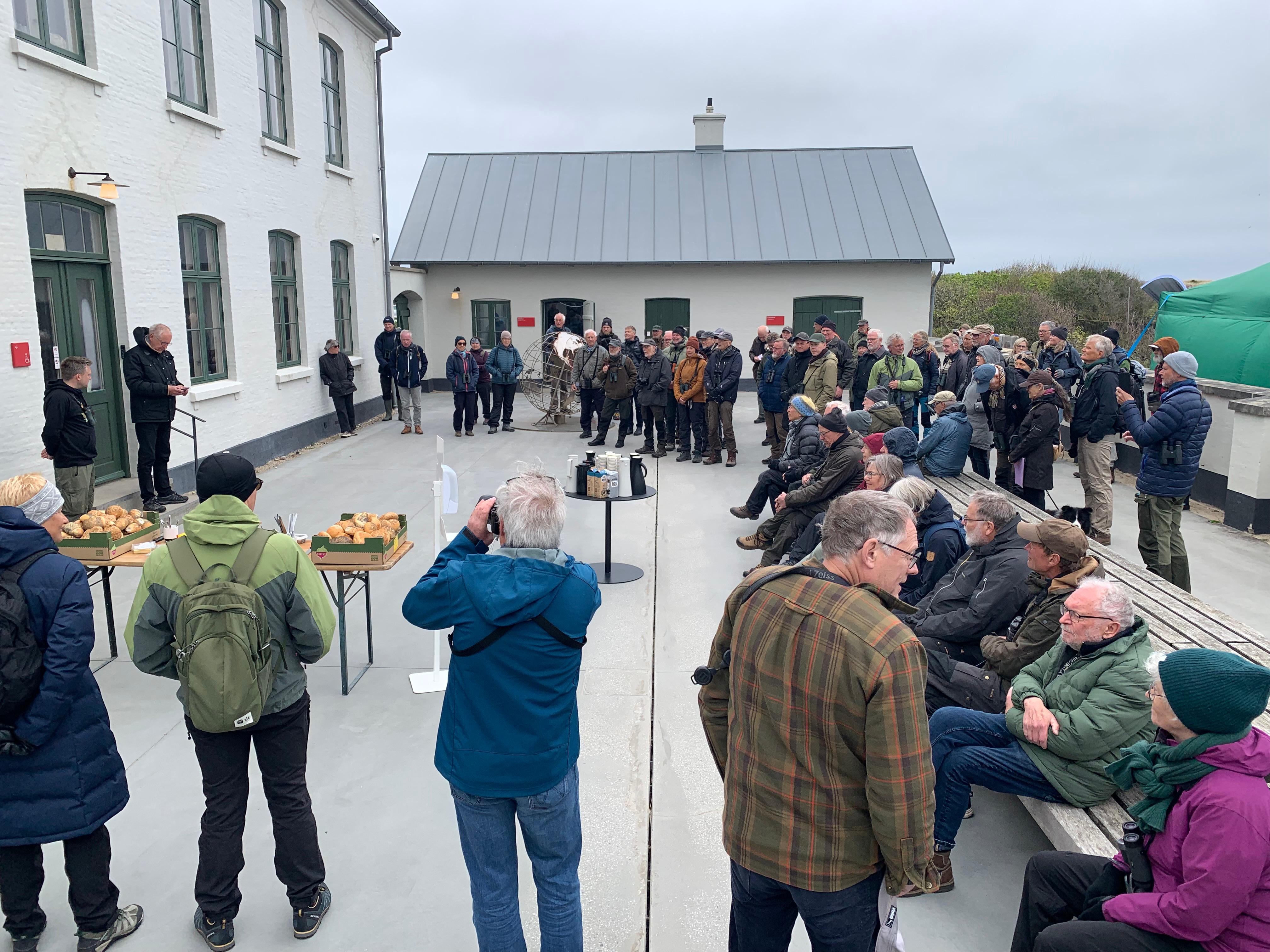
Dagen i går sluttede med at tage imod en ny gæst, Søren, som vi deler værelse med, mens der er fuglefestival. Jeg lavede vegetarisk lasagne efter opskrift af Johanna Ventjeer. Søren spiste også med. Efterfølgende kaldte vi det for en dag, og gik til køjs.
Vi vågnede om morgenen d. 09/05 til omtrent 10 m/s vestenvind, hvilket ikke ligefrem er de bedste forhold for rovfugletræk i Skagen. Alligevel tog vi til Verdens Ende 1, hvor tællingen blev afholdt i dag. I forbindelse med Fuglefestival og DOF Ung’s forårslejr i Skagen var der naturligvis mange mennesker. Mindst 70. Efter et par - lad os bare kalde dem mindre interessante timer - blev der lige pludselig snakket om “en blå fugl” - hvad så end det er for en fisk. Enkelte tænkte, at det måtte have været en gedigen morgen-brandert, mens andre nu også så “en blå fugl”.
Hvad der var tale om, viste sig nok at være en indigofinke. En nordamerikansk art, der typisk bliver holdt i fangenskab i Europa. Der havde inden da været hørt nogle underlige “tik” a la tik-værling eller kernebider, men det lød alligevel anderledes. Fuglen endte med at flyve mod Ellekrattet, inden den blev tabt af syne. I Europa er der ganske få godkendte spontane fund. Blandt andet et enkelt fra England, men dog fra oktober. Den helt store højdespringer er dog Azorerne, med hele 68 fund.
Efter endt morgenobs. gik jeg ud for at hilse på DOF Ung, der stod mellem Sandormesvinget og Verdens Ende 3. Her mødte jeg et par stykker jeg kendte i forvejen, efter ikke at have set dem i flere måneder. Herligt gensyn.

Middagen blev brugt sammen med DOF Ung i Fyrhaven i selskab med omtrent 300 fugleinteresserede og stande med det nyeste grej inden for den optiske verden. Også gratis rundstykker var især tiltrækkende. Midt i den fredfyldte seance, blev der pludselig meldt en rødrygget svale ud fra Verdens Ende 1. Jeg tøvede ikke et sekund med at twitche den, da den tidligere dage havde rastet i området i omtrent ti minutter, inden den så gik retur igen. Med en lidt for spændende cykel rent “hopper-kæden-af?-mæssigt” gik det over stok og sten med alt hvad kæden ville være med til. Træder man for hårdt, hopper kæden af. Efter at være stoppet fire gange for at sætte kæden på, og passeret to andre fra fuglestationen, nåede jeg frem til en lille klit vest for sandormesporet. Her løb jeg op og fik hurtigt godt overblik over området. Efter et kort kig i skopet, finder jeg en svale med lang hale, hvid overgump og manglende pletter på halefjerene. BINGO! Min første rødrygget svale var i hus, efter flere års håbefuld kamp. Det var velsagtens min target-art nummer ét!
Zello gik amok. De to andre frivillige fra stationen ville have opdateringer, hvilket jeg var mand for at levere under hele forløbet. Desværre var det ikke nok til at de fik den at se.
Tilbage på Det Grå Fyr blev eftermiddagen brugt på at sove og lade op til i morgen. Jeg fik blandt andet også vasket tøj, hvilket var tiltrængt - for nu at sige det lige ud.
Aftensmaden blev bikset sammen af Simon Kiesé.
Ud på aftenen blev nyheden om en mulig rødbrystet svale (Rufous-chested Swallow) (Cecropis semirufa) diskuteret ivrigt, inden Johanna Ventjeer ankom til stationen, for at være her et par dage.
/Magpie.

Ringing: Kabeltromlen
Gærdesmutte - Wren 1
Munk - Black Cap 4
Gransanger - Common Chiffchaff 2
Løvsanger - Willow Warbler 4
Broget fluesnapper - Pied Flycatcher 1
Grønsisken - Eurasian Sisken 1
Ringing: Jennes Sø
Gransanger - Common Chiffchaff 1
Løvsanger - Willow Warbler 1
Today’s observations in Dofbasen from observers in the area.
Sum of the raptors in the area based on observations typed into Dofbasen the same day.
People: Michael Ancher, Seán Walsh, Hayley Land, Isis Khalil, Hanelie Sidhu, Magnus Houen Lauritsen, Simon Kiesé, Simon S. Christiansen, Jørgen Hulbæk, Lars and Lone, and our guests Marianne and Kurt.
Wood Warbler and Steppe Eagle
Since the wind turned west, we were not really sure what we could expect today. While the count started slow without many birds to count, the ringing was really good. Many birds seemed to be in the bushes and already in the early morning a nice Coal Tit (Sortmejse) surprised us.
Even more exciting was this Wood Warbler (Skovsanger). This beautiful bird was the fourth one, we could ring this year but it was the first one I had the chance to see in the hand, since I was mostly stuck in busy counts. This was definitly a highlight for me!
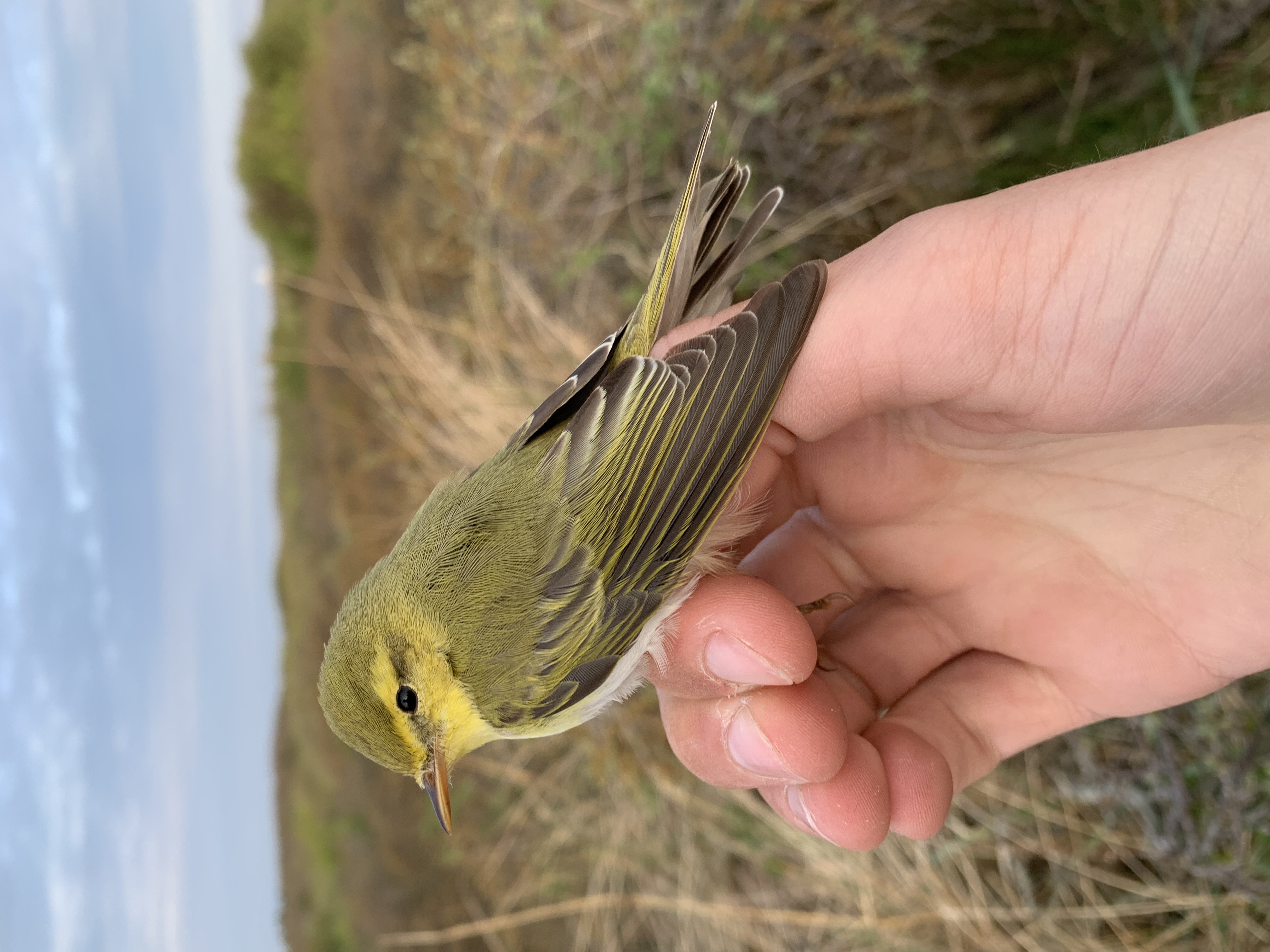
The ringers did really good work and caught one more Wood Warbler. The ringing totals are added like always below.
Even if the count was slow, the diversity of species was great. We could see 108 species including a Great Nother Diver (Islom) and a Curlew Sandpiper (Krumnæbbet Ryle). One Arctic Skua (Almindelig Skua) was swimming on the sea, before deciding to continue its migration. Also a lovely Short-eared Owl (Mosehornugle) showed up.
After finishing the count, Séan and I joined the ringers for a bit. That was really fun and some nice raptors showed up really close. The highlight was the Steppe Eagle (Steppeørn). Usually, we see it pretty distant but today it was super close. I took some pictures with my phone through the scope.
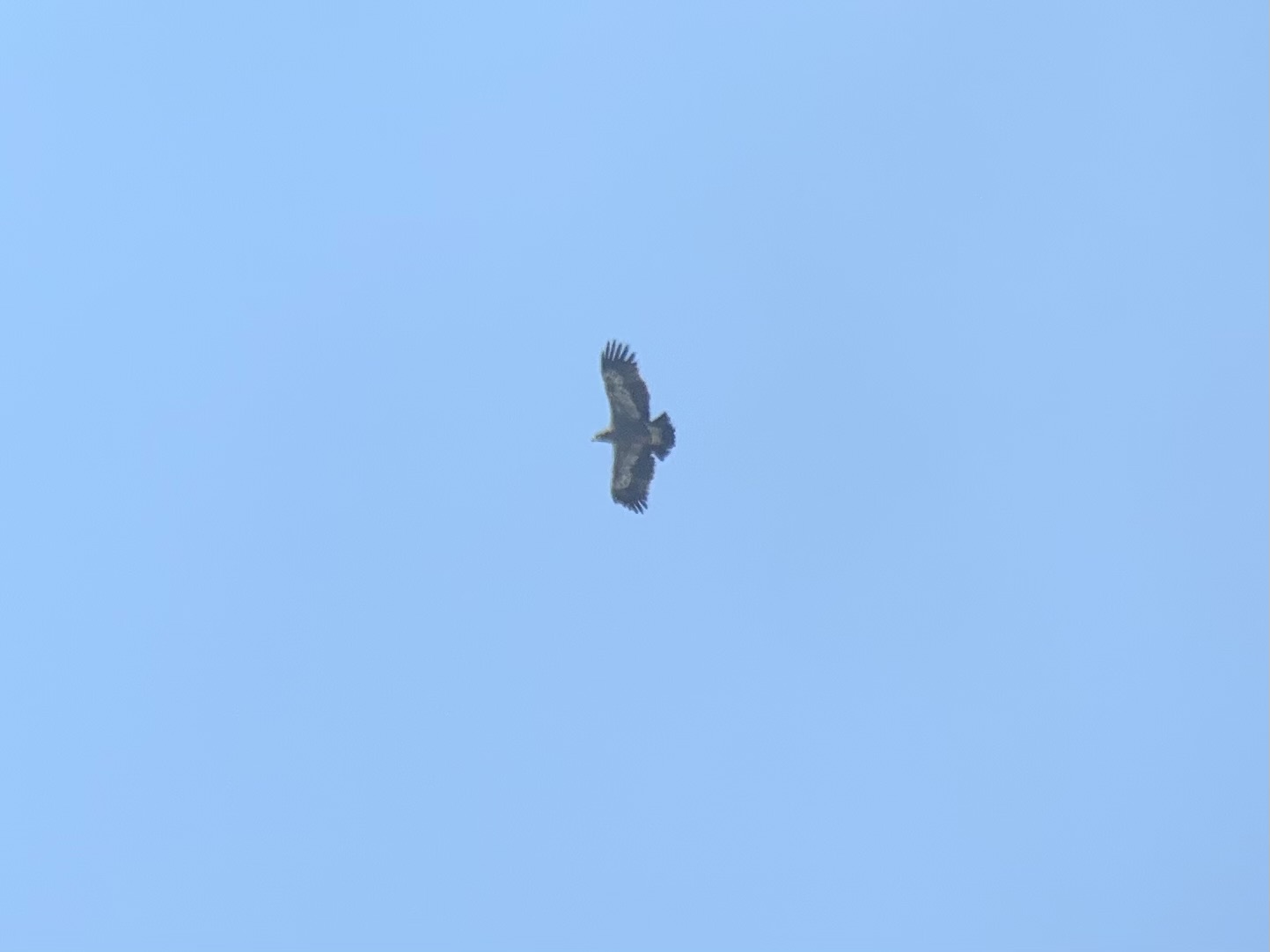
The afternoon was used for a nap and some data entry. This was interrupted from time to time, when exciting birds were put out on Zello. We could see White Storks (Hvide Stork), a adult female Pallid Harrier (Steppehøg) and also the Steppe Eagle (Steppeørn) came again pretty close. Even if we did not see it, a Bee Eater excited many birders. Additionally, the first Golden Oriole (Pirol) showed up.
Tomorrow the bird festival starts. It will be a bit windy but at least friday and saturday looks promising to see more thrilling bird species. Simon Sr. told us, which is planned the following days and we are looking forward to meet many of you in the field! How you would say in german - "keep your ears stiff"!
Ringing totals will be added as soon as they are entered.
Today’s observations in Dofbasen from observers in the area.
Sum of the raptors in the area based on observations typed into Dofbasen the same day.
People: Michael Ancher, Seán Walsh, Hayley Land, Isis Khalil, Hanelie Sidhu, Magnus Houen Lauritsen, Simon Kiesé, Simon S. Christiansen, Jørgen Hulbæk, Lars and Lone, and our guests Marianne and Kurt.
Speedrunners
Simon (Jr), Hayley, and I were up and running at Kabeltromlen this morning, so fast we were even ready early! We were quickly met by Simon (Sr) and Lone (a guest from last autumn) who joined us in ringing for the day. After yesterday’s abysmal conditions, we were very grateful for the clear skies and soft morning sunlight, although it was quite cold. There weren’t huge numbers of birds, but the variety of species made it worth it. We were not alone at Kabeltromlen for long, soon eager onlookers gathered around to watch us ring and see some cool species such as a Reed Warbler (Rørsanger), a few Eurasian Blackcaps (Munk), some Common Redstarts (Rødstjert), and a Tree Pipit (Skovpiber).
A beautiful couple of Eurasian Blackcaps (Munk).
A unique Willow Warbler (Løvsanger), potentially subspecies acredula.
We also had a stunning Red-Backed Shrike (Rødrygget Tornskade) perching by Kabeltromlen. Everybody got to have a very nice look at it as it hopped around in the shrubs and returned to its perch on a branch. What a treat!
Red-Backed Shrike (Rødrygget Tornskade).
Some of the people at Kabeltromlen also experienced the volunteers playing a little prank on Simon (Sr) where we tried to trick him into believing he had forgotten his phone. Unfortunately, Simon (Sr) used his bat senses to see through our joke, but we all still had a nice laugh. Maybe we will get him next time…
Séan and Magnus kept busy at Nordstrand as well. There was a potential Pomarine Skua (Mellemkjove), although in the end no conclusions were drawn as to the real identity of the bird, and it flew very far out to sea. They witnessed large flocks of Common Sandpipers (Mudderklire) flying by the shore, maybe a new Skagen record? Séan also got his lifer Bohemian Waxwings (Silkehale)! Yay!
When we got back to the station, we passed through the shop just in time for Mette to show us the amazing new birds that came in! They look absolutely spectacular, and the Red-Backed Shrike (Rødrygget Tornskade) was perfectly timed.
Eurasian Hoopoe (Hærfugl) in the shop!
The evening was much like every other evening, we had lunch, took care of personal tasks, entered data, and then shared a lovely dinner together that Séan prepared for us. I took a bit of time to download pictures off of my camera from the past few days (it tends to pile up if I don’t get around to doing it frequently!), and then of course I wrote the blog.
Now Magnus has gone out to find a potential lifer (if he succeeds you may read about it tomorrow).
Skifte!
Ringing (Kabeltromlekrattet)
Tree Pipit (Skovpiber) 1
European Robin (Rødhals) 2
Common Redstart (Rødstjert) 3
Reed Warbler (Rørsanger) 1
Eurasian Blackcap (Munk) 7
Lesser Whitethroat (Gærdesanger) 2
Willow Warbler (Løvsanger) 11
Common Chiffchaff (Gransanger) 1
Common Chaffinch (Bogfinker) 1
Pied Flycatcher (Broget Fluesnapper) 1
Total: 30
Ringing (Jenne Sø)
Common Redstart (Rødstjert) 1
Eurasian Blackcap (Munk) 1
Willow Warbler (Løvsanger) 3
Common Chiffchaff (Gransanger) 1
Total: 6
Today’s observations in Dofbasen from observers in the area.
Sum of the raptors in the area based on observations typed into Dofbasen the same day.
People: Michael Ancher, Seán Walsh, Hayley Land, Isis Khalil, Hanelie Sidhu, Magnus Houen Lauritsen, Simon Kiesé, Simon S. Christiansen, Lisa Vergin, Jørgen Hulbæk, Knud Pedersen, Lars and Lone, and our guests Marianne and Kurt
Breaking the streak of good birding days
Hello everyone!
It's nice to be back at Skagen Fuglesation. For those who don't recognize me, I volunteered here at the observatory last year in June and July. I came back again after being told many stories of spring bird migration at Skagen. I arrived again just yesterday, and after spending almost 7 hours on trains from Copenhagen, I was so excited to be a part of ringing and observing operations at the bird station. Well, this morning for my first ringing session here this year, Hayley, Isis and I were greeted with a subpar morning of bird movement. We caught some nice things, such as Pied Flycatcher and Tree Pipit.

We caught 21 birds in total (19 ringed + 2 recaptured), but we were only able to ring until about 08:00. After that, the rain began and the wind slowly kept picking up until it became a danger to birds in the net, so we had to stop ringing.
Magnus and Simon didn't have much more luck than us, having seen more or less the same species as us and very few migrating birds. There was almost no point to the count, although even negative data helps!
Later, after most of the volunteers napped (except for me), Simon Gillings of the BTO gave us volunteers and a few birders of Skagen a lecture on the use of sound recordings and sonograms in bird counting and identification. He showed us how the BTO uses software they developed called Acoustic Pipeline to monitor certain bird populations and how he trains it to become more accurate. He also runs us through how Skagen Bird Station would use the software with our recorders we have in the field.


Ringing (Cable drum hub):
Total: 19
Calling (Nordstjernevej)
Willow Warbler Leaf Warbler 1
Total: 2
Todays observations from observers in the area
Sum of observations of raptors on DOFbasen from today
People: Seán Walsh, Hayley Land, Isis Khalil, Magnus Houen Lauritsen, Simon Kiesé, Simon S. Christiansen, and our guests Dorte and Anders Østerby.
A 'tick' bunting and the Sandhill Crane again
Hanalie and I just about managed to drag ourselves up at 3:30 this morning and out to Kabeltromlen to open the nets but it is getting harder every day! It is the last time Hanalie will ring with us this spring as she migrates south to Gedser Fuglestation today. We all hoped for some really good birds before she left and we were in luck! We had the first Garden Warbler (Havesanger) of this spring's ringing season.

After hearing them singing loudly in the reedbeds we were then very happy to catch our first Sedge Warbler (Sivsanger).
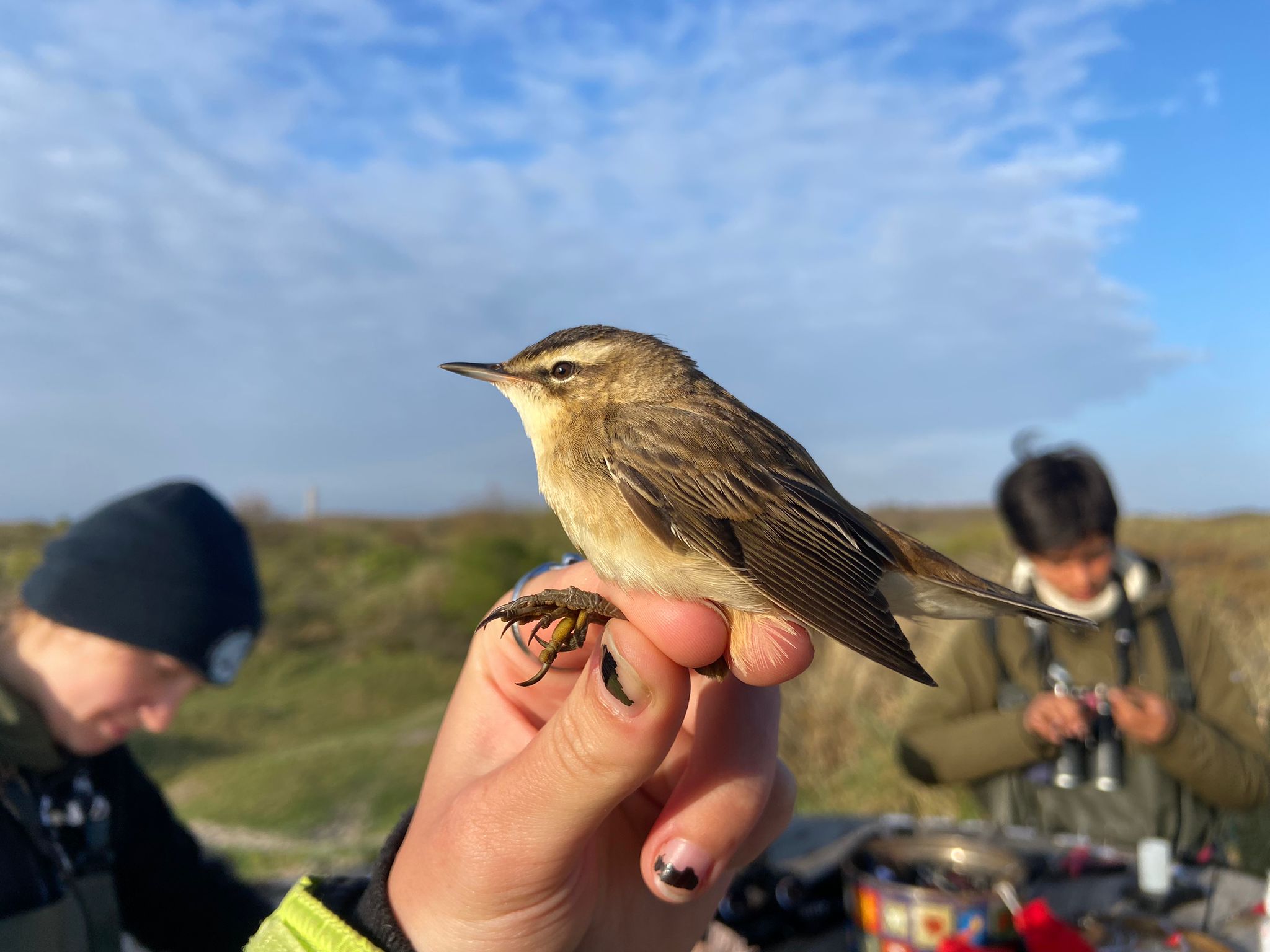
And later in the morning we caught our first Common Whitethroats (Tornsanger). Interestingly, the very first Common Whitethroat (Tornsanger) we caught was a recapture, an adult male first ringed back in 2022.
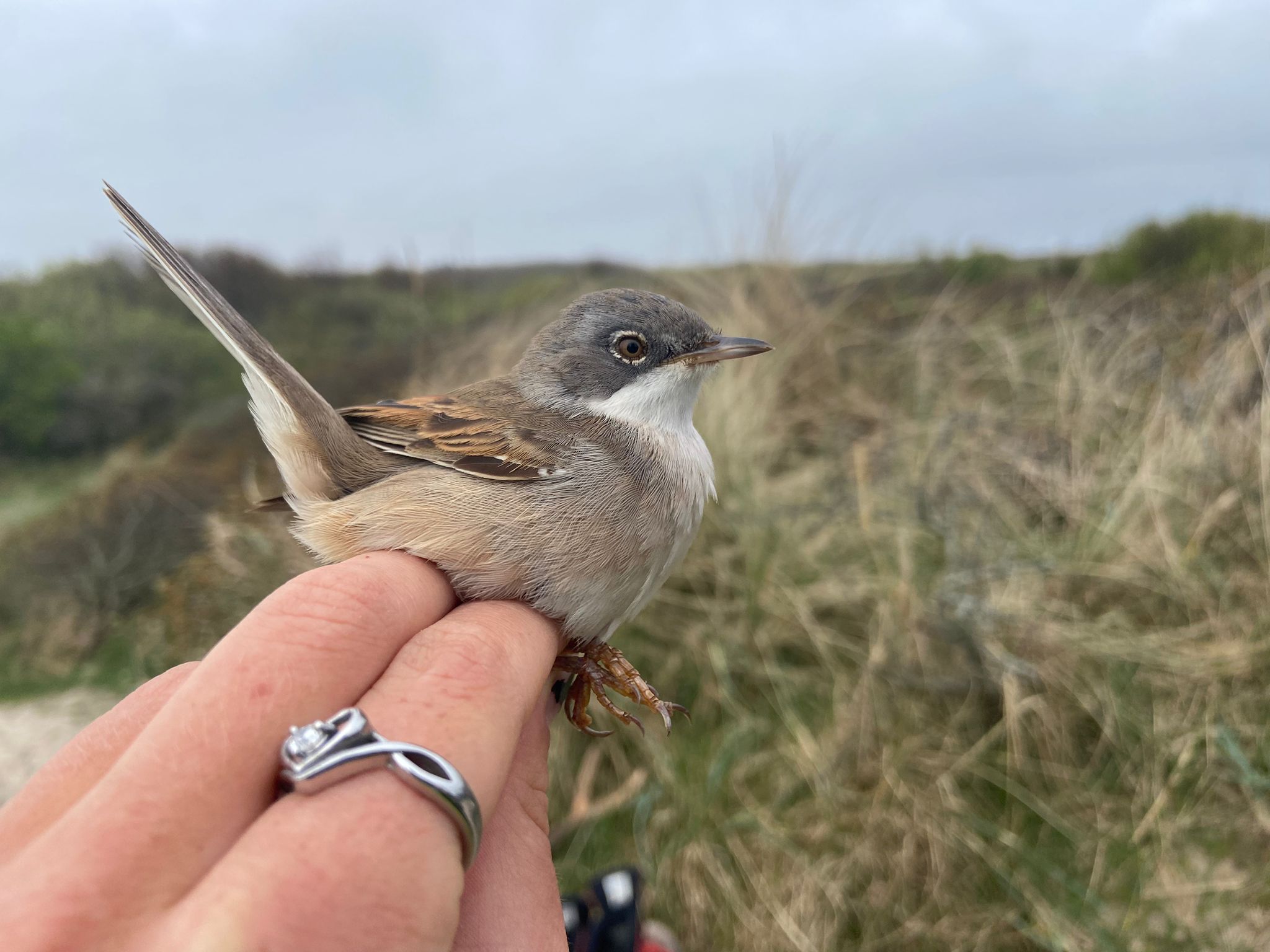
Magnus and Isis had a fairly quite morning at World's End 1. A second calendar year female Pallid Harrier (Steppehøg), a Shag (Topskarv) and a White-billed Diver (Hvidnæbbet Lom) were the highlights. As time went on it got foggier and foggier making it difficult to see far out to sea. However, the morning's excitement increased when a 'tick' bunting was heard at World's End 1 and seen flying towards Kabeltromlen. Magnus immediately sent a Zello message to Simon Jr who called out 'shhh' and everyone at the ringing went completely silent. The bird flew over and Simon managed to get a sound recording of its call. This will be analysed along with some distant photos taken to identify the species as either Little Bunting (Dværgværling) or Rustic Bunting (Pileværling).

The day got even better when we heard over Zello that the Sandhill Crane (Prærietrane) was on the move from Jerup, heading north with a flock of Common Cranes (Trane). Everyone at Kabeltromlen was prepared with their scopes and binoculars and before long the flock was spotted, 16 Common Cranes (Trane) and one Sandhill Crane (Prærietrane). They headed out over Grenen and over the sea and may have been found later in Sweden.
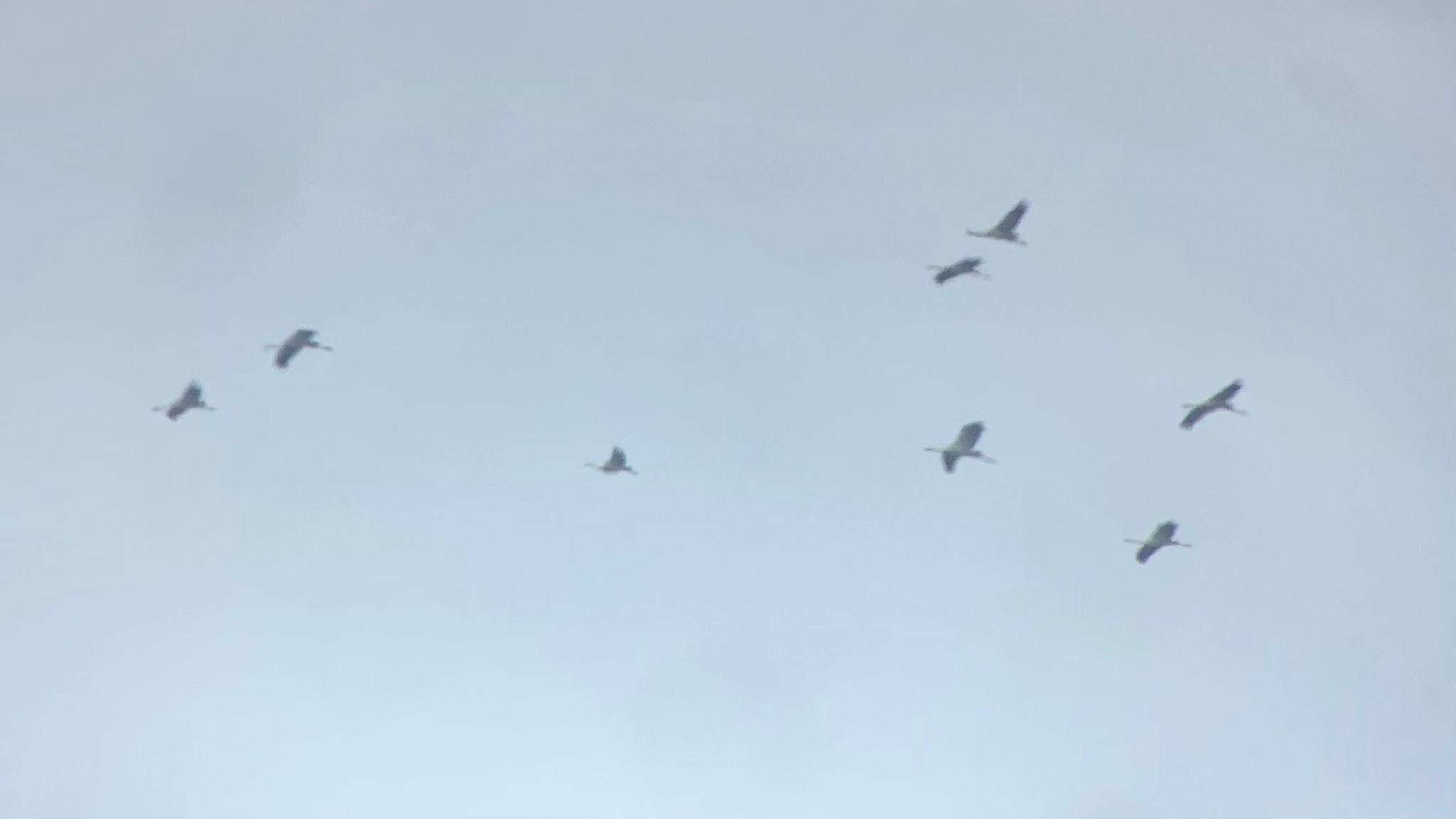
And it didn't stop there! A Steppe Eagle (Steppeørn) was also seen circling over the town.
There was a great atmosphere at Kabeltromlen all morning; it was busy with lots of different birders and turned into quite a party with cake and chocolate (tak for that!) and lots of interesting conversations.

The only downside to the morning was Hanalie leaving the station to continue the season at Gedser Fuglestation. We hope she has an amazing time and sees lots of great birds whilst she is there. Thank you for your lovely message in the guest book, we will miss you!
When we finally got back to the station we had a delicious lunch of leftovers from Dorte and Anders’ cooking last night. This was followed by cake and chocolate mousse from Mathilde and the people at Blink. It was delicious, tak!
The afternoon was busy too with cleaning the apartment, entering lots of data, analysing the bunting sound spectrogram, fixing bikes, having our ‘mid-stay’ talks with Simon Sr, and food shopping. We also welcomed Séan, our newest volunteer from Ireland, who will stay here for the rest of the season. Welcome back to the station Séan!
Ringing (Kabeltromlekrattet):
Total: 65
Ringing (Jennes Sø):
| Robin | Rødhals | 1 |
| Lesser Whitethroat | Gærdesanger | 1 |
| Common Whitethroat | Tornsanger | 1 |
| Blackcap | Munk | 2 |
| Willow Warbler | Løvsanger | 8 |
| Pied Flycatcher | Broget Fluesnapper | 2 |
Total: 15
Ringing (Nordstjernevej):
| Wood Pigeon | Ringdue | 1 |
| Willow Warbler | Løvsanger | 1 |
Total: 2
Todays observations from observers in the area.
Sum of the raptors in the area based on observations typed into Dofbasen the same day
People: Séan Walsh, Hayley Land, Isis Khalil, Hanelie Sidhu, Magnus Houen Lauritsen, Simon Kiesé, Simon S. Christiansen, Jørgen Hulbæk, and our guests Dorte and Anders Østerby.
Battle of the Towers and a Sandhill Crane
Who can see the most species in one day from one spot?
To find out we moved to World's End 1 early in the morning to do our daily count and also the Tower Battle with a nice group of 10 Birders. The goal was to see as many species as possible from our spot without moving somewhere else. The morning started early with a singing White-spotted Bluethroat (Sydlig Blåhals) which made the fitting soundtrack to the calm weather and the nice sunrise. It did not take long until the first Pallid Harrier (Steppehøg) passed by and headed out to sea towards Sweden. During the morning we saw 4 young birds (2nd cy) and one adult male. Otherwise two Montague's Harriers (Hædehøg) flew out and even with fewer birds over sea than yesterday the species list added up bird by bird. Nice arrivals like Sedge Warbler (Sivsanger) were very welcomed by us. At noon the Battle of the Towers was finished with a great total of 105 species - just 4 under the highscore, which was set up in Skagen.
The ringers also participated in the Battle of the Towers and gave their very best to get new songbird species for us. The best catch of the day was definitely the third Wood Warbler (Skovsanger) of the year! It is such a beautiful species and I've still not seen one in hand (you will read in a second why I was not at KAB at that point). Hopefully that will change soon.
When the message came, that there is a Sandhill Crane nearby in Jerup, we got really excited. Luckily Jan offered to take Hanelie and me with him (tak!!), so we quickly left and started our small twitch. When we arrived the Sandhill Crane (Prærietrane) was foraging in mid distance on a field together with Common Cranes (Trane). What a beautiful bird!!! Since it was a new species for Hanelie and me and we had great company with Jan, the mood was awesome. Some Corn Buntings (Bomlærke - why do danish people call this Bunting a Lark?) were nice to see and we heared our first Cuckoo (Gøg) of the year.

Luckily for my sleep bilance, I decided to take a nap in the afternoon. This is a risk, because you can miss some birds but thanks to Zello we are always alert if there are really good birds around. Since some clouds came and slowed down the migration, there were not many birds to miss. So we could go over to deal with the administrative tasks, we did not have any time for yesterday.
Tomorrow Hanelie will leave. It was really nice to have her as a hard working volunteer, keen birder and friend. To fill this hole, Séan will join our team for the rest of the season. I met him in my first week of stay here last summer (in end of july) and it was a fun time, so I'm really looking forward to meet him again.
Ringing (Kabeltromlekrattet):
Total: 42
Not just us, but also Michael ringed today. Those are his numbers:
Ringing (Nordstjernevej):
| Willow Warbler | Løvsanger | 1 | |||||||||||||
| Lesser Whitethorat | Gærdesanger | 2 |
Total: 3
Ringing (Jennes Sø):
| Pied Flycatcher | Broget Fluesnapper | 4 | RI | |||||||||||||
| Common Redstart | Rødstjert | 2 | RI | |||||||||||||
| Lesser Redpoll | Lille Gråsisken | 1 | RI | |||||||||||||
| Willow Warbler | Løvsanger | 4 | RI |
Total: 11
Todays observations from observers in the area.
Sum of the raptors in the area based on observations typed into Dofbasen the same day
People: Hayley Land, Isis Khalil, Hanelie Sidhu, Magnus Houen Lauritsen, Simon Kiesé, Lisa Vergin, Michael Anker, Troels Eske Ortvad, Mads Bunch, Simon S. Christiansen, Jørgen Hulbæk, Hendrik and our guests Dorte and Anders Østerby
